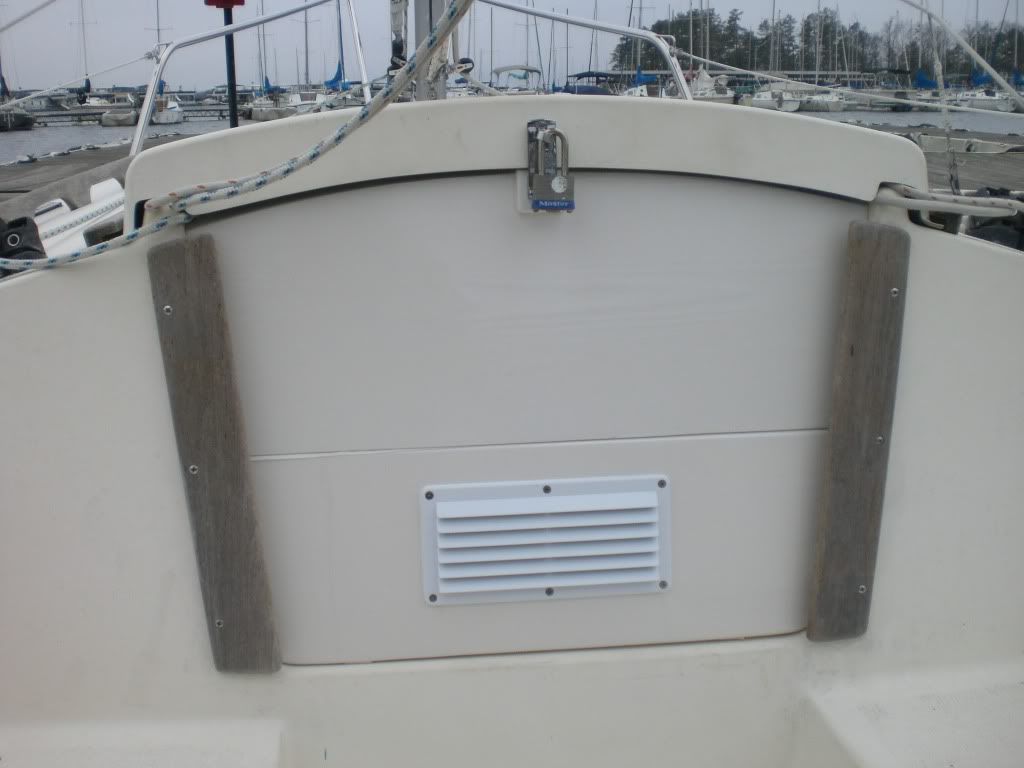"We gotta have that funk."
- Parliament Funkadelic
Over time, old boat cabins develop a unique scent, an olfactory stew comprised of (more or less) equal parts bilge water, engine oil, fuel, mildew, leaking toe rails, hanging foul weather gear and bathing suits, damp cushions and spilled beer.
Old Boat Smell clings to all fabrics aboard, including real-world-employment clothes, prompting co-workers to comment that you smell
faintly like your boat.
Truth be told, I like Old Boat Smell. It smells like....
Victory.
Note the bold face a few lines back.
Faintly.
That is the key to successfully carrying off Old Boat Smell on the dirt.
If your boat's essence fogs along behind you like a cloud of gulls trailing the wake of a fish tug, you're doing it wrong. You want envious dirt-dwellers to note that you smell faintly like your boat, not to faint due to your boat smell.
The challenge is how to balance on that fine line of funk.
To keep Old Boat Smell down to socially acceptable levels, the concerned boater has to address ventilation, condensation, moisture intrusion,bilge emulsion, internal combustion emission and probably a whole bunch of other words that end in "ion."
Here is what we have learned over the years.
Whiskeyjack is blessed with a surfeit of ventilation. Cowl vents aft of the mast, a big forward hatch covered by an awning, a fan and a screened companionway door all keep air flowing down below. As we all know, air flow is the way to go if you don't want Old Boat Smell to grow, yo.
I figure ventilation can be divided into two categories: Passive and active. Passive ventilation is airflow with assistance, ie vents, while active ventilation is assisted air movement, ie fans. Effective ventilation to prevent the proliferation of odour is ventilation that works all the time, whether the boat is closed up or whether one is aboard, day or night, so to that end passive ventilation is the place to start.
If you don't have any, or enough, ventilation, add some. The simplest solution is to slightly crack hatches and ports, but the additional ventilation will mean the introduction of more moisture with the participation of passing precipitation.
It may mean cutting some holes, to install vents.
I like cowl vents.
image courtesy of defender.com
I really like cowl vents with dorade boxes.
 image courtesy of thaiteakmarine.com
image courtesy of thaiteakmarine.com
Air goes in, but water stays out.
 drawing courtesy of Sparkman and Stephens
drawing courtesy of Sparkman and Stephens
Simple and effective, cowl vents can be turned to make best use of available breeze, or to provide a vacuum effect- one vent pulls fresh air in, one vent exhausts air from below.
Some folks like solar vents.
 image courtesy of defender.com
image courtesy of defender.com
Essentially a low profile vent with a solar powered fan built in, these cowls will move large amounts of air and can be configured as either intake or exhaust fans. I have no experience with them, so offer no opinion other than to point out that they are twice the cost of old-school unpowered cowl vents.
Adding louvers or clamshell vents to the companionway hatch is a simple low-buck way to get more air flow.
 image courtesy of winterwoodworks.com
image courtesy of winterwoodworks.com
Louvers don't have to be fancy to be effective. PVC or stainless louvers are available for under $20
 image courtesy of cpyoa
image courtesy of cpyoa
However while companionway louvers are great in all weather to allow air to exit, another inlet vent needs to be installed forward to allow fresh air to enter.
Or, keep the forward hatch cracked slightly, and hang a hatch tent.
You can
build your own

or buy one:
 image courtesy of defender.com
image courtesy of defender.com
Air in, rain out, with the added bonus of not waking up when the crack of dawn beams laser-like through the open hatch.
Once you've got air coming in and going out, the next step is to increase comfort by hurrying that air up, by inviting some active ventilation to the party.
There are lots of fan choices out there, some like the Caframo Sirocco...
 image courtesy of defender.com
image courtesy of defender.com
... draw an astonishingly small amount of power. The
Caframo fans are not the cheapest fans on the market but they move a lot of air without a lot of noise at less than .5 amps. They even have a timer option, and a low battery shut off. If the cabin on
Whiskeyjack was larger, and/or if our sailing season more intemperate, one or more of these would be at the top of our list.
We have had a low-buck spring clamp- mounted Canadian Tire auto accessory aisle-sourced fan hanging aboard the boat for four seasons. Seen hiding behind the chartplotter below.

It was on sale for $8, and it still works for the half dozen or so times each season we feel the need to move more air.
Right, then, ventilation is covered.
With air coming in and going out, the next step is to prevent funk-loving moisture from entering. Chase down the leaks on the boat and this time, do something about them. Rebed leaking stanchion bases, seal leaking ports, pull and pot grab rails, and cleats and anything else leaking that shouldn't be. It's a job easier with two people than one, and a great how-to write-up can be found
here.
Now, with air passing through successfully, and water unsuccessfully, dry out the bilge and
CLEAN. Clean the bilge, clean the lockers, clean the engine, clean the upholstery, clean the head. Pile everything that can be removed on deck or on the dock. If it doesn't take you at least half a day, you're either already compulsively neat, or you missed something.
Do this at least once a season. if you haul your boat for winter like we do, do it at least at splash and haul out.
I'm not going to get into cleaners other than to say that I've tried any number of specialized marine cleaners and found that in most cases a good household cleaner is as effective and smells better. In fact, we've discovered that this stuff

...is the best stuff we have ever used for cleaning spider poop. Spray, wipe, done.
If you're still with me this far, I'm now gonna break your heart.
You've put all this time, effort and money into making your boat impervious to water entry while allowing air to come and go as it pleases... and you're still going to get moisture on board. All because of you. Yes, it's your fault.
Perspiration, respiration, habitation all lead to...
...condensation.
(Hey, look, it's not my fault so many of the damn words in this post are suffixed "ion' I didn't create them, I just have to use them. Sorry for the frustration.)
In fact, as silly, counter-intuitive and just plain wrong as it sounds, running a heater in cold weather can increase moisture aboard.
How does one solve this phantom unavoidable moisture?
Well, duh. Add more dryness aboard.
Silica gel.
 image courtesy of popularmechanics.com
image courtesy of popularmechanics.com
When you buy a pair of shoes, electronics, furniture, one of these little "do not eat" pouches is invariably nestled somewhere in the box. These packets are perfect for keeping small lockers, drawers and tool boxes dry. Furniture is often shipped with silica gel bags that are the size of your fist, perfect for keeping v-berths dry. Tuck them in the corners, or if you want to get fancy, sew little mesh bags to dress them up and hang the packets in the hanging lockers, tuck them on shelves, wherever they will be out of the way.
Stop by your local furniture store and ask for discarded silica gel. Or better yet,
come see me and buy some furniture. Ask for the Dock Six Discount.
Or, you can get all fancy and
buy silica gel .
You know what? Your boat will probably
still stink. Mildew is pernicious stuff, in the words of Vincent Price, "the funk of forty thousand years..."
We've found a really good solution.
Last spring, at
Bridge Yachts Open House I met a representative for Kanberra Gel,
 image courtesy of amazon.com
image courtesy of amazon.com
touted as being the bee's knees in boat odour abatement. I received a sample and mentioned that I would give it a try onboard.
Marco's boat
Candy III became the test bench for this evaluation. His boat had a seriously smelly, Dee-won't-even-think-of-going-in-there -even -after- it- has -been -cleaned mildewy- smelling cuddy cabin. I gave him the small sample of
Kanberra Gel I had received and asked for his feedback. By small, I mean,
small- my sample was a plastic container with a flip top lid about 1" in diameter, about 1/4 ounce. A few days later Marco invited me aboard his boat and the boat smelled faintly of tea tree oil, not strongly of damp towels. The mildew smell was completely abated for the rest of the season. I am impressed. Few products meet the hype attached to them, but Kanberra Gel walks the walk.
Now you know how to turn a sows ear of stink into a silk purse of aroma. Give it a try, and if you have any tips to add, let me know, and don't forget to ...
"Talk the Dock!"






































